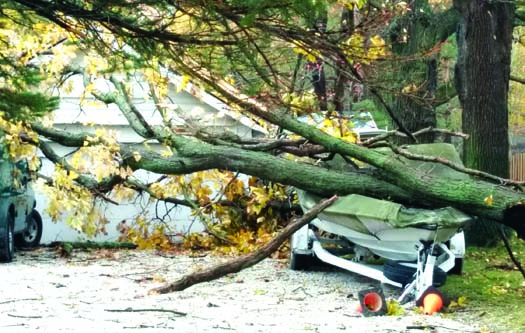Harsh winds and rain rolled into northeast Ohio in the early evening of November 5, when a cold front moved across the Great Lakes. The National Weather Service reported a confirmed 14 tornadoes across northern Ohio and western Pennsylvania. In addition, there were a large number of areas, such as North Royalton, with straight-line wind damage.
“Unseasonably warm and humid air was in place across the region ahead of the front. The cold front gradually progressed across the Ohio Valley and thunderstorms initiated and swept east ahead of the front,” according to the National Weather Service. “The storms formed in a very strong wind field and allowed the storms to move very rapidly east at speeds of 60-80 mph. Some storms became tornadic with over a dozen tornadoes produced across northern Ohio and NW PA. A large microburst formed and swept east just south of Cleveland and produced winds in excess of 100 mph.”
A microburst is a downdraft that affects an area of less than 2-1/2 miles wide and peak winds lasting less than five minutes. “Microbursts may induce dangerous horizontal and vertical wind shears, which can adversely affect aircraft performance and cause property damage,” according to the National Weather Service. “Straight-line winds are generally any wind that is not associated with rotation, used mainly to differentiate them from tornadic winds.”
Although there was not a reported tornado in North Royalton, the storm wreaked havoc across the city. “Everything started about 6 p.m. and went through midnight,” said Fire Chief Bob Chegan. “The first couple hours were complete chaos.” He said they had 42 calls during that time; 60 calls within 24 hours and 80 calls through Tuesday. Unfortunately, he said there was no mutual aid available, as surrounding communities were dealing with much of the same. Luckily, there were no reported injuries. Most of the calls were related to trees and power lines that were blown down by the winds. “Some areas experienced significant damage,” he said.
Chegan has been busy filing reports on the various incidents that took place within the city, for potential funding through county, state or federal agencies. At the time of this writing, the area was not declared a disaster area. Chegan said that unfortunately, there is very little financial assistance available through the Federal Emergency Management Agency (FEMA). He noted that in order to declare a natural disaster, certain criteria, such as cost of damage must be met. He said he did not think this event came close to the threshold in order to be qualify. The city had received assistance in the past. When Superstorm Sandy headed this way in 2012, the city received about $70,000. In 2014 with the flooding event, it received close to $500,000. The funding covered the cost of such things as personnel and materials.
The North Royalton Police Department records show that trees were down on Bennett Road, Wallings Road, Ridge Road, Albion Road, Harbour Light, Essex Circle, James Drive, State Road, Wiltshire Road, Valley Parkway, York Road, Evergreen, Washington Avenue, Tudor Circle, Donmar, Creek Run, Titan, Cady, Sprague Road and Kingston Way. Many trees took down power lines. There were power outages citywide and multiple intersection lights out. FirstEnergy reported that around 17,000 customers in the northeast Ohio area were without power. Some in North Royalton did not have their power restored until Tuesday, November 7.

By GLORIA PLEVA KACIK
Contributing Writer














